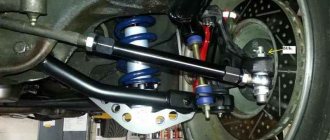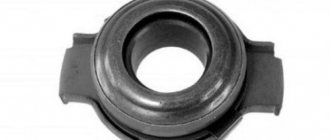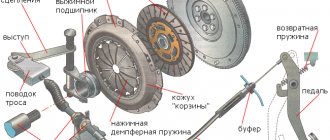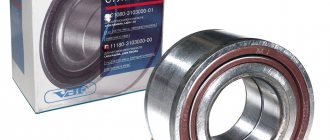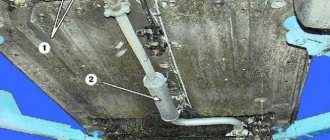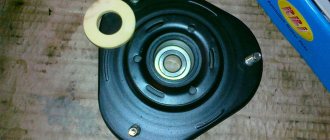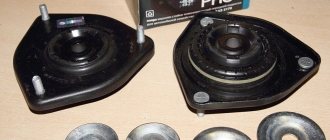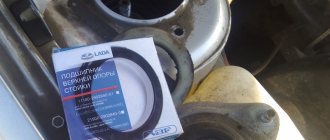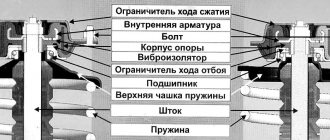Signs of a support bearing failure
The first warning sign that something is wrong with the support bearing is most often a knocking sound coming from the area of the front right and left side members. Many suspension parts can creak and knock, but it is best to start checking with the support bearing. The most unpleasant sounds will appear when driving on uneven surfaces, when the car is heavily loaded, and also when making sharp turns. Also, the driver will probably notice a general drop in the car’s handling. Inertia occurs in the steering. The car may begin to “scour” along the road.
It is worth adding that most often manufacturers determine the service life of support bearings at 100 thousand kilometers. However, if the machine is operated in difficult conditions, parts may need to be replaced after 50 thousand. There are cases when the support bearing “flies” even after 10 thousand km.
What indicates a malfunction
It is not always necessary to undergo complex diagnostics and a visit to a service station to understand that the support bearing has come to an end.
In fact, there are two main indicators of a breakdown or, at least, an unsatisfactory condition of the device, which requires mandatory replacement in the near future.
Many cars experience a knocking noise. But this is not true for all cars, since knocking in the struts may be absent due to design features
Therefore, motorists more often pay attention to changes in steering behavior. It is more difficult to steer a car; you constantly need to steer if you are driving in a straight line
Moreover, when it leads in one direction or another, you can understand what kind of persistent problem it is.
Causes of failure
Everything about the signs is very clear. But you need to know why such a malfunction occurs, and try to prevent premature wear of the support bearing on the front struts in the future.
- Natural destructive processes. Each OP has its own resource, which is usually developed after 80-100 thousand kilometers. Sometimes, if operating conditions are difficult, wear occurs faster. Therefore, it is better to check the condition of the OP every 20 thousand km.
- Aggressive driving. If you like to race, corner sharply and literally rape your car, which I categorically do not approve of, then your OP will not last anywhere near 100 thousand km. Such piloting speeds up the wear process significantly.
.
- Questionable bearing quality. Many car owners try to save money by buying cheap parts. But they serve little purpose and can fail at the most inopportune moment. Therefore, dear car owners, do not skimp on such important things.
- Terms of Use. You can drive extremely carefully, but if you regularly drive on broken roads, off-road and other conditions that are not the most pleasant for the car, the OP will wear out faster.
- Lubrication. It may be of poor quality, and therefore does not adequately simplify the operation of the bearing. Plus, some lubricants are sensitive to low temperatures. When purchasing and applying lubricant, make sure that it is of high quality and can withstand the upcoming loads, as well as operating conditions.
Causes of bearing failure
The main cause of support bearing failure is dust and water, which inevitably penetrate inside. The lack of lubrication does not have the best effect. Sharp blows to the rack will not add to the service life. It is worth taking into account the quality of roads, because they have a direct impact on the natural wear of the support bearing. That is why, with us, a part can wear out faster than its manufacturer claims.
Dirt and sand are some of the hardest impacts on a bearing. We remember that a journal bearing is a type of rolling bearing, and it does not have any protection mechanisms against harmful factors. Driving at high speeds and harsh brakes, especially on bad roads, also do not add to the service life of the part in question. However, not only the bearing itself suffers from this, but also all other suspension elements as a whole will soon require repair.
Why is the wheel bearing humming?
There are several reasons:
- dirt getting inside the cage;
- the presence of wear products inside the rolling elements area (abrasive effect);
- impact damage;
- improper installation is a common problem in self-repair;
- excessive load (large vehicle weight, aggressive driving);
- sudden thermal changes;
- large wheel offset from the axle;
- incorrectly selected outer tire radius.
It is worth adding a poor-quality wheel alignment installation. Further operation of the vehicle leads to avalanche wear of friction pairs. The result is that the unit begins to hum, then a cracking sound occurs.
Note:
Part failure is especially dangerous on trucks and large buses. Under the pressure of weight, the assembly passes the stage of gradual wear and tear and collapses catastrophically quickly.
How to check a support bearing
There are three methods for checking the support bearing at home: Remove the protective caps and press the upper element of the front strut rod with your fingers. Now we begin to rock the car from side to side by the wing. We do this both longitudinally and transversely. If the bearing fails, you will hear the same knocking noise as when driving. At the same time, the car body will swing, but the pillars will either stand still or swing with less amplitude.
You can place your hand on the front shock absorber spring coil. Then you need to turn the steering wheel in different directions. For this you will need an assistant. If your hand feels a recoil and a metallic knock sounds, things are bad with the bearing. You can also drive first on a flat road, and then on a rough one, and listen to what sounds the car makes. If you hear metal knocking from the front arches under extreme loads, then the problem is most likely in the support bearing.
It is worth understanding that partial or even complete failure of the support bearing is not a critical failure for the car. However, this does not mean that you can safely drive such a car. In addition, in domestic realities it is better to carry out diagnostics every 10-20 thousand kilometers. It doesn't matter whether there are signs of a malfunction or not. This approach will first of all allow you to save on repairing other elements of the car’s suspension. This applies to shock absorbers, springs, protectors, tie rod ends and the rods themselves. In order to slow down wear, you need to remember to change the oil on time.
You need to maintain your car regularly, otherwise you can become an example of careless and dangerous “care” for your car. And that's not very fun.
1200 rub. for the photo report
We pay for photo reports on car repairs. Earnings from 10,000 rubles/month.
Write:
When malfunctions occur in the front suspension of a car, one of the first measures that its owner should take is to check the support bearing located between the support and the upper spring cup. To do this, you will need to grab the “cup” of the rack with your hand (put your hand on the support) and rock the car. Constant, sharply changing loads, including shock loads in combination with abrasive dust particles, contribute to the wear of the components of the support strut bearing and ultimately completely disable it. As a result, it begins to play, knock, squeak or squeak, and the shock absorber rod deviates from its axis.
Diagram of the support bearing operation
Such problems with its operation can lead to more serious consequences in the car’s suspension. Since wear of the support bearing will lead to a violation of the wheel alignment angles, and consequently, a deterioration in the car’s handling and accelerated tire wear. How to check and which manufacturer of thrust bearings to give preference to when replacing - we will tell you about all this in more detail.
Guide to replacing front support bearings (using the example of the Hyundai Elantra).
- Jack up and remove the wheel.
- Using two appropriately sized keys, unscrew the stabilizer link from the shock absorber, first from the top with a 17 key, then from the bottom with a 19 key.
- Remove the 12mm bolts securing the brake hose and ABS.
- Next, disconnect the lower shock absorber mount from the hub.
- Remove the support post by unscrewing 3 12 mm nuts.
- Clamp the shock absorber in a vice. Using a special compressor, compress the spring so that it moves away from the cups - the top and the shock absorber.
- Holding the shock absorber rod with a hexagon, unscrew the fastening nut, and then remove one by one: the strut support, the cup with the bearing, the spring, the bump stop with the boot, the lining rubber.
- Reassemble the removed elements in the reverse order, replacing the faulty bearing with a new one.
- Check that the wheel alignment is set correctly and, if necessary, adjust it - at a service station or with your own hands using the methods described in the article “Do-it-yourself wheel alignment.”
Signs of a faulty support bearing
The main sign of a breakdown, which should alert the driver, is a knocking sound in the area of the front left or right side members . In fact, other suspension parts can also be sources of knocking and squeaking, but you need to start checking with the “support”.
Unpleasant sounds are especially noticeable when driving on uneven roads, over potholes, on sharp turns, and when the car is heavily loaded. That is, in conditions of critical suspension operation. In addition, the driver will probably subjectively feel a decrease in the car’s controllability. The steering does not respond so quickly to its actions; a certain inertia appears. The car also begins to “scour” along the road.
Replacing the front strut support and bearing
The work is carried out in a garage. The presence of a pit or lift is not necessary.
What tools are needed to replace
- Socket wrench with curved handle.
- Special head for disassembling racks.
Select a head after consulting with a consultant, all tools are different
Causes of failure
The main reasons for the failure of support bearings are dust and water penetrating inside, lack of lubrication there, and also, not rarely, due to a strong impact on the rack. Read more about these and other causes of support bearing failure:
- Natural wear of the part . Unfortunately, the quality of domestic roads leaves much to be desired. Therefore, when operating the machine, be prepared for the fact that the bearings will be subject to more wear than their manufacturer claims.
- Sand and dirt getting inside the mechanism . The fact is that a journal bearing is a type of rolling bearing, and it does not structurally provide protection from the mentioned harmful factors.
- Abrupt driving style and failure to comply with speed limits. Driving on bad roads at high speed leads to excessive wear not only on the support bearing, but also on other elements of the vehicle’s suspension.
- Low quality parts or defects . This is especially true for domestically produced bearings, in particular for VAZ cars.
Replacing a bearing with a separate element
If the support itself is in order, and the fault concerns only the bearing, it can be replaced separately. To do this, remove the rack with the support (the process is described above) and deal with it separately.
Having disassembled the support (the design is different for everyone, but the principle is approximately the same), we inspect the bearing. As a rule, the balls are worn unevenly, there are burrs on the holder, and the seals are damaged.
It is possible that the problem can be solved with little blood
Although journal bearings can usually be disassembled and individual components can be accessed, there is no point in repairing them.
It is hardly profitable to tinker with the component parts of the support bearing, trying to repair them
Firstly, the bearing itself separately from the support is not that expensive.
Secondly, this is a critical unit, so replacing balls or seals using a makeshift method will not lead to anything good. Therefore, it is a clear replacement.
It is safest to replace the entire bearing
Whether to change bearings in pairs or not - there is no consensus. Typically, paired replacements are made more due to reinsurance. Experienced service station workers determine this need based on the general condition of the car’s suspension. It also happens that it is not practical to change the second bearing - why throw away a well-functioning part?
How to carry out work on an Opel Astra (video)
How to check a support bearing
Next, we will consider the question of how to determine a faulty support bearing with your own hands based on a characteristic sign. This is quite easy to do. To recognize how support bearings knock, there are three methods for checking the support bearing at home:
- It is necessary to remove the protective caps and press the upper element of the front strut rod with your fingers. After this, rock the car from side to side by the wing (first in the longitudinal and then in the transverse direction). If the bearing is faulty, you will hear a familiar knocking noise that you heard when driving a car on a rough road. In this case, the car body will sway, and the stand will either stand still or move with a smaller amplitude.
- Place your hand on the front shock spring coil and have someone sit behind the wheel and turn the steering wheel from side to side. If the bearing is worn out, you will hear a metallic knock and feel the recoil with your hand.
- You can focus on sound. Drive your car on uneven roads, including speed bumps. When there is a significant load on the suspension system (sharp turns, including at high speed, driving over bumps and holes, sudden braking), a metallic knocking sound of the support bearings will be heard from the front wheel arches. You will also feel that the car's handling has deteriorated.
Checking the “supporters” on VAZs
How do support bearings knock?
To extend the service life of a given bearing, very often, if the design allows it, mechanics wash and change the lubricant. If the part is partially or completely out of order, the support bearing is not repaired, but replaced. In this regard, a logical question arises - which support bearings are best to purchase and install?
Ford Mondeo support bearing repair
Detailed photo instructions on how to independently restore the performance of a Ford Mondeo support bearing. Do-it-yourself repair of the support bearing of the Ford Mondeo shock absorber strut Read more
Shock absorber (car shock absorbers)
The shock absorber ensures safety and comfort when driving by absorbing shocks, jolts, and vibrations of moving suspension elements. Therefore, it is important to promptly eliminate shock absorber problems—properly maintain them and replace them in a timely manner. More details
Checking car shock absorbers
This video shows the consequences of faulty shock absorbers, and also describes popular testing methods: swaying, behavior on the road, what to look for during visual diagnostics Read more
What is a support bearing and what function does it perform?
Bearings are an important part of many machines. They are designed to restrain moving parts of a machine. Bearings reduce friction between the moving parts of the car in the process. They are available in many different types.
The support bearing of the car strut is necessary to provide a movable connection between the shock absorber and the car body itself.
In most popular cars, the shock absorber support bearings are located on the rotation axis of the front shock absorbers. They support the spring and shock absorber assembly and allow the shock absorber assembly to rotate when the steering wheel is turned. These two pieces allow you to address the most common reasons for replacing shock absorber mounts and understand when your shock absorbers need to be replaced. Meanwhile, their position just below the frame mounts suggests how much tension they receive between the weight of the car (top) and the weight of the spring (bottom).
How to choose support bearings
So, today on the auto parts market you can find “supports” from different manufacturers. It is best, of course, to buy original spare parts that are recommended by the manufacturer of your car. However, most car owners, as an alternative, buy non-original bearings in order to save money. And here a kind of lottery arises. Some manufacturers (mainly from China) produce quite decent products that can, if not compete with original spare parts, then at least come close to them. But there is a danger of buying an open marriage. Moreover, the likelihood of purchasing a low-quality bearing is much higher. We present to you information about popular brands of journal bearings, reviews of which we were able to find on the Internet - SNR, SKF, FAG, INA, Koyo. When purchasing branded products, always pay attention to the presence of branded packaging . It is, in fact, an analogue of a passport for a bearing, which is usually issued by domestic manufacturers.
SNR - thrust and other bearings are produced under this brand in France (some production facilities are located in China). The products are of high quality and are used by various car manufacturers in Europe (such as Mercedes, Audi, Volkswagen, Opel, etc.) as originals.
| Positive reviews | Negative reviews |
| SNR bearings are made of very high quality; if you take proper care of them, they will give you twice the service life specified by the manufacturer. These bearings have very good carburization of the working surface; if you do not overheat it and take care of the lubrication, it becomes indestructible. | Unfortunately, after only six months it broke down for me - it began to buzz noticeably. Before this, the car ran for 8 years on factory bearings, until the right one flew off after falling into a hole. I used the new bearing from May to October on a wheel with a cast balanced disk, then I changed to a new, also balanced, stamped one with winter tires, and then in February the buzzing started. I didn’t get into any potholes, I didn’t exceed the speed, the disc and tires were in order, and this SNR was ordered to be urgently changed during maintenance. |
| I have installed SNR bearings many times and never encountered any problems. They fit into place without problems, mileage is excellent. The safety margin is clearly decent, since even if a bearing fails, it still leaves quite a lot of time to find a new one and replace it. It's noisy, but it drives. | Like many car enthusiasts, I often have to deal with the problem of spare parts. Of course, I would like to buy something that is not expensive and of high quality, but as often happens, these two factors are not comparable. I can't say the same about the SNR bearing. The bearing is relatively inexpensive and, if used correctly, can even last its entire life, but it’s better, of course, not to take risks - drive it as long as it’s supposed to, take it off and install a new one. |
SKF is an international engineering company from Sweden, the world's largest manufacturer of bearings and other automotive parts. Its products belong to the top price segment and are of high quality.
| Positive reviews | Negative reviews |
| In general, these bearings have been time-tested and are quite suitable for installation. If, of course, you are satisfied with the standard support, and the car suspension in general. The only negative is that you can’t buy it everywhere and not always. | Everyone here praises SKF, but I will say: a bearing without lubrication or a lightly lubricated one does not find much and SKF makes good money from this. Their quality is low. |
| SKF is a proven, reliable brand. I changed the bearing, I got it from this manufacturer, it serves without any complaints... | — |
FAG is a manufacturer of bearings and other spare parts for mechanical engineering. The products are distinguished by their reliability, quality, and belong to the expensive price segment.
| Positive reviews | Negative reviews |
| The bearings are fully worth their price. Yes, they are expensive, but they last a very long time. Even on our dead roads. | No negative reviews were found. |
| These are on my Mercedes M-Class. Replaced under warranty. No problem. | — |
Popular questions
Installing the inner CV joint boot
Posted: 06/18/2014 Last week we changed the inner boot of my brother on his fawn. Not the easiest procedure, but nothing particularly complicated. They removed the axle shaft, removed the outer CV joint and its boot, and then pulled the outer...
More details
Oil pressure sensor repair
Posted: 06/08/2014 Replacing the oil pressure sensor is probably one of the easiest things to do. And not only in terms of the low complexity of the process itself, but also in the low time investment. The main thing is to find out why...
More details
Installing rear struts
Posted: 11/30/2014 I have a VAZ 2109, I change the struts myself when I have time, it’s not difficult, although the first time I also sweated a lot. In general, you need to start by loosening the nut, it secures the upper support of the rack, is located in the glass to...
More details
Removing the rear fender
Posted: 07/20/2015 Friends, I hasten to share with you my experience on how to remove the rear wing. After reading this message, you may be surprised and will not believe that this can be done with your own hands. I advise you to save...
More details
Engine protection repair
Posted: 12/02/2014I bought a seven-year-old Toyota Corolla. Upon closer examination, I noticed the absence of crankcase protection; there was a plastic boot; of course, this did not interfere with the purchase. I drive carefully, I don’t drive recklessly, however...
More details
Replace oxygen sensor
Posted: 11/25/2014I encountered a similar problem about six months ago, also at a very inopportune moment. We were going to my mother-in-law’s dacha; it wasn’t her birthday. The car was acting a little strange. I arrived at the wrong time for...
More details
Repair of front struts
Posted: 06/16/2014If you have a head on your shoulders and your arms are growing from where they need to be, then you can try to change the front struts yourself. Personally, I had such a need when the car dealership announced the cost...
More details
Remove the rear seat
Posted: 07/19/2015 I removed the rear seat on a Toyota Crown car. The lower part of the seat, as you know, can be removed quite simply, thanks to the snap fastenings. But with the upper part, still...
More details
Alternator belt repair
Posted: 05/01/2016 Please show me how to put on the alternator belt on a Gili Emgrand car
More details
How to change a water pump
Posted: November 25, 2014 I replaced the water pump for the first time this year. And myself. First, I disconnected the battery terminals, drained the coolant from the cooling system, then installed the piston of the first cylinder in the right position...
More details
How to check silent blocks?
A flat mount will be required for diagnosis. This will allow you to determine how badly these parts are worn. Using the mount, the lever will move in the longitudinal and transverse directions. If there is play or damage, then the front suspension silent blocks are to blame for the knocking.
Sometimes the levers can be collapsible. Then you can replace it with a silent block. To do this, the lever is dismantled, and then, using a special mandrel, the part is squeezed out. It is advisable to lubricate the new silent block before installation. The seating surface must also be cleaned. After installation, the knocking should stop.
How to replace supports yourself
No pit or overpass is required to dismantle and install the support. All work can be done with the help of a jack and a partner. Their sequence is described below:
- Unscrew the top rod using two keys.
- We jack up the car. The lower part of the support is removed from the bowl and then removed.
- After removal, thoroughly clean the support seat from dirt and corrosion, treat it with a rust converter and tint it.
- We assemble the stand and install it in place.
- We attach the strut to the lower arm.
- Raise the body on a jack so that the wheel remains on the ground.
- We install the support.
- The assistant slowly lowers the jack.
- Gradually align the position of the rod in the support.
- After installing the rod, tighten the support nuts, taking into account the tightening torque specified in the instructions (use a torque wrench).
- The completion of the repair is a test drive on an empty road (you should not go onto city streets until you are sure that the steering is working properly).
If the support itself has no complaints, but the bearing has served its purpose, you can only do its replacement. To do this, we dismantle the rack and support. We remove the bearing. Clear signs for replacement:
- uneven wear of balls;
- scuff marks on the clip;
- destroyed seals.
The bearing itself can be easily disassembled into its components, but it must be replaced as a whole. This spare part is inexpensive, and the responsibility on it is too great to repair it manually.
Steering
Even for experienced service engineers from numerous car repair shops, finding the cause of extraneous knocking noises is a serious problem. Many people immediately recommend replacing the shock absorber strut. Here it is, new, on the car, and the strange knocking noise in the front suspension on small bumps has not gone away. The car owner goes to another service center, but there they offer him to replace the support bearing, but even after that the knocking noise does not disappear.
When diagnosing the front suspension, experienced car owners begin checking with the steering system.
Replacement
Replacing the front support bearings is quite simple. The main thing is to find a really high-quality part, because not all manufacturers can provide supports with a high degree of wear resistance. So, we arm ourselves with the following tools:
- spanner;
- head for disassembling racks;
- spark plug head for ratchet;
- rod nut wrench;
- spring compressors.
And, of course, the prop himself. We will carry out the replacement procedure as follows:
- Jack up and remove the wheel.
- Remove the two nuts securing the front strut to the hub.
- Unscrew the nut from the shock absorber rod, while holding it with a hexagon.
- We remove the stand.
- Compress the spring and remove the support bearing.
- We again clamp the hexagon on the rod and unscrew the nut.
- We remove the bearing, install a new one and repeat all the steps, only in reverse order.
The cause of knocking while turning may be a malfunction of the steering rack, steering shaft or steering cardan. Therefore, after replacing the support, the problem may not disappear. In this case, all of the above systems should be checked.
Video on replacing the support:
The main causes of vibration in the steering wheel
Among the popular reasons that cause a slight knock in the front suspension on small bumps is a large gap between the steering rack and gear. This is the result of wear and tear. To make an accurate diagnosis, it is recommended to pull the steering rods up and down. At the same time, carefully observe the movement of the rod. If she doesn't move, then she's fine. If the rod dangles, then most likely the bushings are worn out.
If the rack turns, then the accurate diagnosis is a large gap in the engagement. But this problem can be easily eliminated by tightening this very rail. Also, when pulling the steering rod, you may notice broken or overly worn bushings securing the steering rods to the steering rack.
Another possible cause of knocking is the steering joint. Testing this hypothesis with both hands will be quite difficult. You'll need a friend's help. The assistant must turn the steering wheel very quickly and sharply, and the car owner must grasp the hinge in such a way as to hold the hinge itself, its body and finger. If there is wear, you can feel the play. Then suspension repairs will not be necessary in the near future, and you will only have to buy and replace the hinge bushing.
CAN THE NEW SHOCK ABSORBERS KNOCK?
It happens that knocking occurs on new shock absorbers that have just been installed. Due to the fact that the parts have just been changed, they are the last to be “sinned”, looking for reasons in other suspension elements. But even new shock absorbers create extraneous sounds. There are several reasons for this - a manufacturing defect in the damper, unreliable fastening, mismatch or defective rubber bushings.
You need to buy a new shock absorber complete with bushings that fit this model.
Factory defects are rare, but this reason should not be ignored, and if knocking noises appear, even a new element should be checked. Extraneous sounds may appear due to unreliable fastening of the part in the rack housing. The element is fixed in the body with a nut and if it is not tightened enough or is loose, the damper will move along the stand, creating knocking noises.
In shock absorbers installed outside the strut (lever and semi-dependent suspensions), extraneous sounds appear due to inappropriate or depressed rubber bushings installed in the mounting lugs.
Upper rack support
This can also cause knocking in the front suspension over small bumps. On car forums, the topic dedicated to this knock is very popular. The reasons are different for everyone. In attempts to combat this annoying sound, car owners go through the entire suspension, but often the knock remains.
One possible cause is the upper strut support. It consists of a rubber part as a damper and a bearing. If this rubber element has lost its elasticity, then this is the cause of this extraneous knock that all drivers struggle with. In order to find out for sure whether this is so, measure the gap between the limiter and the support. In most cars this is easy to do, but in some models this unit may be closed. If measurements show that the gap is more than 10 mm, then the support must be urgently replaced. However, this gap is not always uniform. When measuring, it is recommended to focus on the average figure. It is worth checking this support carefully: on many cars this sound appears only on one side.
Repair of shock absorber strut support
If it turns out that the bearing is in order, and the cause of the knocking lies in the wear of the damper or other element that is not a critical component of the structure, the support can be repaired.
How to restore a bearing: reconstruction of the pillow on video
In this case, we see a working rubber cushion, which simply changed size during use. Shrinkage can be compensated for by installing a machine-made gasket.
It will not be possible to return the support to 100% performance, but you will ensure a mileage of several thousand kilometers, and without any visible problems in comfort and safety.
Despite the fact that the shock absorber strut support is a critical component, its functionality can be restored without contacting service. Depending on the severity of the damage, you choose between installing a new unit, replacing worn components, or repairing it. The decision depends on your qualifications and the cost of components.
Roads are called one of the two main “troubles” of Russia. Constant holes and potholes cause not only inconvenience in terms of comfortable movement, but also cause significant damage to the car’s suspension, its individual elements, especially bearings. Replacing them is not difficult, even a beginner can handle it, but diagnosing the need for this replacement in a timely manner is much more difficult, especially without knowing the signs of a faulty support bearing. We will talk about them further, but first a little theory.
Worn support bearing
These sounds appear in the same way as with an inelastic damper, but they are sharper and much louder. In order to make an accurate diagnosis in this case, it is necessary to remove the stand. It is recommended to take into account one rather interesting feature that is inherent in such breakdowns: bearing wear is always uneven. So, maximum wear is where it is constantly located when the car is driving straight. If after turning the steering wheel the knocking noise disappears for a while, then it is definitely a support bearing.
There is also another diagnostic method. It is quite old, but effective. You will need an assistant again. The second person should rock the machine up and down. At this time, the driver should feel the shock absorber rod with his hand. The knock will be transmitted to this rod.
Another possible reason is that the nut on the upper support is loosely tightened, sometimes this happens.
What does the sound say?
The sound of a working car should not cause discomfort.
Any unpleasant noise indicates that one of the components or assemblies is not working properly. You need to respond to symptoms immediately, otherwise the principle “one breakdown leads to another” comes into force. A knock is a play formed in any unit that occurs due to natural wear. The noise comes from rubbing parts. The noises and knocks are very similar to each other. In addition, very often they add up, for example, faulty ball joints and play in the front hub bearings or steering tips.
To determine the location of the noise and/or knocking, you must first determine which side it is coming from. If you have already established the approximate location of the noise, then finding it will be much easier. Observing what the sound is synchronized with and under what conditions it occurs will also help.
Spherical bearing
On car forums, in topics dedicated to this knock, a variety of reasons for knocking in the front suspension are discussed. Ball joints are one popular reason. One can say even more - this is a classic among all possible sources of extraneous knocks.
But there is one peculiarity here. On front-wheel drive cars, knocking noises from ball joints are very rare. It is more typical for classic VAZ models.
Thus, a worn joint can cause sharp vibrations when crossing small irregularities in the road. It is quite easy to diagnose this malfunction - pull the front wheel in a transverse direction. Naturally, it is advisable to lift the car for this. Beginners may confuse play in the ball joint with wheel bearing movements. In this case, the assistant must hold the brake before pulling the wheel, this will eliminate the hub play.
Sometimes an extraneous knock can be caused by a real trifle - check the rubber boots. Hinges cannot last long if the protective cover is torn.
Diagnostics of bearing units
It is important to detect the first signs of wear on the elements in time - this will give you a small margin of mileage before replacement. Determining how a bearing hums is quite simple: remember the sound of an accelerating electric train or subway train and compare it with the noise of a car's chassis.
Comment. Do not confuse the hum of worn-out hub mechanisms with the howl of “rogue” transmission units - the gearbox and rear axle gearbox. The sounds are very similar, but the transmission howls in certain modes - under load (acceleration), or vice versa, after releasing the accelerator pedal. The wheel bearing is constantly noisy.
At the first stage of wear, the humming sound of bearing mechanisms appears at a speed of 40–50 km/h and increases as the vehicle accelerates. Later, a crackling and knocking sound is added to the hum, indicating partial destruction of the separator and the rollers falling out. At the last stage, the part falls into pieces, the wheel jams or turns across the road, which poses a great danger to car passengers and nearby pedestrians.
How to find out where a wheel with a bad bearing is located:
- First, listen carefully to where the sound is coming from - from the front or rear axle. If in doubt, check the noise change during a sharp turn. A bad front hub part will make a louder noise.
- Having eliminated 2 serviceable wheels, proceed to diagnosing the remaining hubs. Lift each side of the car one by one, hang the wheels and manually try to swing them along the axis of rotation in the vertical and horizontal plane. An increased backlash will indicate a worn part (small play is quite acceptable).
- To prevent wheels from wobbling due to broken ball pins, have an assistant press the brake pedal while checking. The play has disappeared - the bearing is definitely to blame.
- Rotate the suspended wheel quickly. If you hear extraneous knocking noises or rotation requires some effort, the problem is in the bearing assembly.
- The deterioration of the cage and rollers causes vibration, which is felt by touching the hub with your hand as the wheel rotates.
It is quite difficult to determine by ear which bearing has finally worn out when two parts located on different axes fail at once. The hum comes from both sides, it is impossible to localize the fault. There are two ways to clarify the location: hang and check all the wheels one by one, or use a service station lift.
A faulty bearing mechanism always heats up more intensely than the rest . If you hear a humming noise while driving, stop and feel the hub nut caps to compare the temperature. Unfortunately, this method is not applicable when decorative caps are installed - by the time you remove them, the metal parts will cool down.
Rack
Very often, knocking in the front suspension on small bumps is attributed to this particular unit. In reality, the stand is the source of knocking in very, very rare cases. But it’s worth checking, because this is a very important unit.
A heavily worn, very weak strut, even if it has not yet leaked, can cause shocks. When the car moves and the wheels fall into a hole, the rebound force of this strut is not enough, and it is not able to prevent the spring from straightening. The stand shoots the wheel down. When the wheel either touches the hole or hangs in the air, it stretches to its maximum. There will be a blow in both the first and second cases.
Rack diagnostic methods
There are a lot of methods. The classic one is to swing the body down, and it should smoothly rise to its normal position and stop. If everything is so, then the rack is working.
It happens, although quite rarely, that the strut makes extraneous sounds due to its internal problems, for example, the nut that holds the piston has become unscrewed. However, this does not cause knocking. When driving, the car sways and controllability decreases. In this case, replace the strut and repair the suspension.
Various shock absorber breakdowns are the consequences of its improper use. The oil in these systems must have a special specific viscosity, which also depends on the air temperature. Having warmed up the engine, the driver immediately takes off, but the oil in the rack has not warmed up. If it’s frosty outside, then the viscosity in the stand is too high. In this case, thin and very fragile parts fail.
Thick oil may also not be related to the weather. Sometimes excessively thick liquid is poured into shock absorbers. This is done to increase the resistance force and so that the oil does not “run away”. But as a result, stability and controllability deteriorate, because hard does not mean good.
Rear suspension
Rear axle rods.
On rear-wheel drive cars, when starting and braking, a knocking sound is often heard due to wear on the bushings. Or, after sharply pressing the gas pedal, the rear of the car is pulled slightly to the side - the direction of movement of the car has to be corrected by the steering wheel. The faulty rod needs to be replaced.
Rear brakes.
When you press the brake pedal, is there a noise or vibration throughout the body? This is a common problem in wet weather. This is usually due to a thin layer of corrosion or dirt on the pads or the inside of the brake drums. In this case, try driving a hundred meters with the handbrake slightly extended - the layer of corrosion will disappear as a result of friction.
Unpopular reasons for knocking
It would be a good idea to check the anti-roll bar bracket. This part consists of bushings based on metal and rubber, which are turned in different directions and connected by a thin isthmus. Most often it is he who breaks down. On rough roads, on small bumps and on turns, you can hear a knocking sound.
For a correct diagnosis, you need to pull the end of the stabilizer with one hand. This will work better if the wheels are turned to the right.
It happens that the motor mounts wear out. The engine moves actively at increasing speeds and on uneven surfaces. At certain moments, he reaches the body with the generator and oil pan. The result is a knock. This source of knocking is rarely guessed at. Many people change the suspension, but replacing the front suspension does nothing in this case.
Anything can knock in cars. For example, washer barrels. If it is poorly secured in place, the race will knock. There are also many other mysterious culprits behind such sounds.
More about bearings
The front shock absorber upper mount bearing is a type of antifriction bearing. Its main difference is that its outer ring is much thicker. To accept loads from different directions, it has cylindrical rollers, which are located perpendicular to each other, or balls. Each is separated by a separator.
The cage is a distinctive part of rolling bearings. It is a metal ring with round holes. Thanks to it, the rotation speed of the bearing increases and more lubricant flows to the rollers. The function of the separator is only to hold those same rollers (or balls), and it no longer bears any load.
There are four types of bearings used in cars: a bearing with a built-in ring, with a detachable inner ring, with a detachable outer ring, and a single-split type front shock absorber support bearing.
Brakes as a source of knocking
Sometimes sounds coming from the suspension are actually coming from the brakes. It happens that a car enthusiast has checked everything and replaced everything that can be replaced. The front suspension layout has already been learned by heart, but the knocking was still there.
To make a diagnosis, you need to move. If the knocking noise disappears when braking, and when the pedal is released, it resumes again, then the brake pads are to blame. The same problems can occur after installing new pads.
If the car is knocking, do not rush to repair the chassis. Perhaps the extraneous sound is caused by a completely different reason. In this case, only a complete diagnosis can help. It may be enough to replace the front suspension silent blocks and the sound will disappear forever.
Malfunctions in the engine compartment
Generator belt.
The problem manifests itself with a high-pitched squeal after starting the engine or with a sharp increase in speed. To stop it, the belt needs to be tightened. Didn't it help or did the sound come back after a while? Replace with a new one.
Water pump.
It is faulty if, at idle, a rumble and/or a thin whistle is heard from the front of the engine compartment. In this case, it needs to be replaced.
Ignition.
A metallic ringing knock when accelerating a car indicates detonation (explosion of a flammable mixture in the combustion chamber). Most likely, the ignition is set too early, you filled in low-quality gasoline, or a large amount of carbon deposits has formed in the combustion chamber. In addition, the cause of detonation may be engine overheating or old spark plugs. The above sound is produced by the engine pistons, which receive the shock wave from explosions of the fuel mixture in the combustion chambers. Driving for a long time with such a sound leads to engine destruction. Therefore, it is better to immediately go to an electrician.
Timing belt
The noise of the gas distribution mechanism (GRM) against the background of the general operation of the engine can be heard very clearly. A loose chain produces a rattling-popping sound, which intensifies as the engine speed increases and disappears when the gas is released. True, if the car is equipped with a timing belt rather than a chain, there will be no alarming sounds before a break (it just needs to be changed every 60-100 thousand km, depending on the manufacturer’s recommendations). A belt break is usually accompanied by a loud metallic impact sound, which indicates that the driver is “in trouble” for at least $1000 in major repairs.
Valves, pistons and bearings.
There are a number of ways to check the quality of the overhaul without disassembling the engine. To do this, just listen to the engine. Thus, in the event of a malfunction, the crankshaft main bearings emit a metallic dull sound if you sharply press the gas pedal at idle speed. The frequency of knocking increases with increasing crankshaft speed. A sharper sound and at uneven intervals causes excessive crankshaft end play. The connecting rod bearings produce an even sharper sound. If only one of the journals is faulty, then the location of the knock can be easily determined by turning off the spark plugs one by one. Crooked pistons make a muffled knock. A knocking sound from the intake or exhaust valves, heard at regular intervals, is most likely a signal that the valves require adjustment, or the valve mechanism has increased wear, or one of the elements of this mechanism has broken. When the engine picks up speed and the knocking suddenly begins to intensify, then most likely the reason is that the valve clearances are increased.
